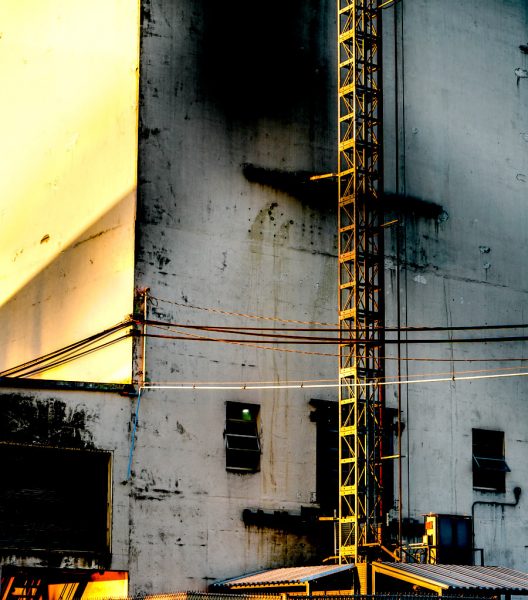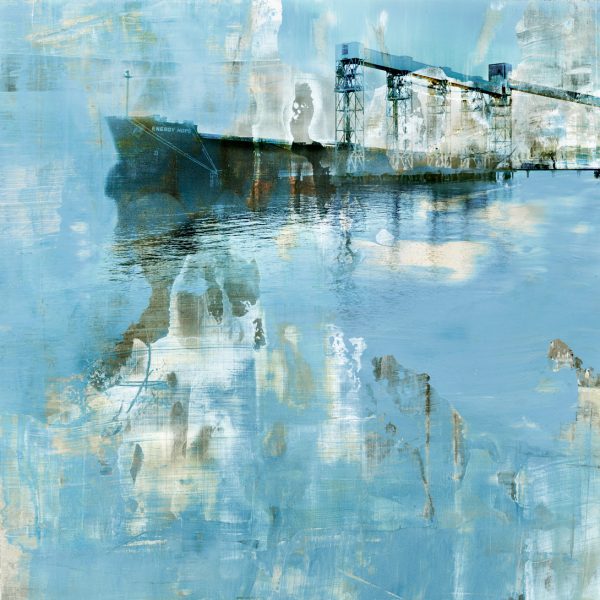
Industrial silence is a three part harmony of dripping rust, heavy metal and the slanting light of late afternoon. If you listen carefully you can hear walls corrugating and wire mapping a path through the milky green of ancient skylights. In the distance, there is the hum of large trucks idling, and close up the interrogating roar of generators programmed to shock a tourist out of reverie. There is always the cantor and the choir of crows and gulls, one shrieking, one mewling, and sometimes thin coils of rubber poised like snakes. Most of the written words are warnings. Wear your steel toe boots, don’t touch, don’t trespass, turn this crank to the left and then up, do not drink what is in this barrel, although I always hope somewhere in the sans serif commands I will find an anthemic “raise high the roofbeam carpenters!”
Every silence is different, but each one reminds me of the other, so as I walk through train yards and factories on Sundays when everyone is gone I also think of Berlin, when there was still a Berlin Wall, and an East, and the very particular sound of museum silence. My footsteps echoed, each step shadowed by that of a guard. The glass cases holding single objects were dim with dust and only one light burned, high up in the ceiling and careful with its brilliance, as though to protect the dust from heat so it would not evaporate. I felt like a trespasser, yet even with my eager high school German I could not find the words or the courage for apology. Later I sat outside on a bench and observed the Wall until another guard indistinguishable from the first came up to me and with arms folded arms over his rifle barked, umlauts in full tilt, “It pleases me not that you here sit!” (Anthemic, that.)
Since then, whenever on expedition I take care not to be caught in a state of observation. The silence of industry commands attention. It’s dangerous. It’s hard and heavy and useful and big. If I pause for a minute and consider all the machinists and the history of machining that went into making screws and bolts, the hydraulic lift, the evolution from hammer to jackhammer, from bucket relay to conveyor belt, I get positively faint with awe and disbelief. The iconic factories and structures that draw me in have the darkness and the dirt and the mystery of the Berlin museum. They are legacy still standing, and nothing is disguised as something else. Unlike the sleek interface mediating modern experience, in a grain elevator I can see the rivets. The imminent hazard and physical presence of industrial silence, its sense of authority, is a welcome counterpoint to the intangible machine of modern life which is no less dangerous, but mostly unseen. When you can hold the most powerful device in modern life ™ in one hand and turn it on and off with a thumb it’s hard to sustain a state of awe. It’s magic, but designed to be taken for granted and then to become an essential accessory you only truly value when the data runs out. It is a device of such intimacy that it becomes part of your body, designed primarily to inspire involuntary spasms of constant hunger. On the other hand, there are objects destined for use, even if you aren’t entirely sure for what.

The history of photography has been a history of a new medium trying to understand its relationship to painting, drawing and printmaking. Photography tried first to legitimize itself by assuming the atmospheric and surface qualities of painting. With the advent of the Machine Age and the Precisionist movement, the romance of painterly illusion gave way to a new one: the romantic purity of documentation, bowed in reverence to the Machine. After decades of breakthroughs in the achievement of the photographically real a new cycle is beginning, influenced by technology that allows unlimited ways of merging pictorial means.
Charles Sheeler, the seminal industrial artist and photographer said, “Photography is nature seen from the eyes outward, painting from the eyes inward.” In a mixed media era an artist can look outward and inward at the same time, with a gaze that builds as much on ambiguity as proof. My new industrial work moves back and forth between languages, blending paint, photography and the art of the print. Romance and reality unexpectedly intersect. When I looked closely at the ship in “Eventide” I had to smile at its name. Energy Hope. I always have to make choices, between the abstract distance and the literal truth. What better name for a ship filled with grain and beans? You can track its progress through the high seas here.

“Eventide 2,” a mixed media print, will be part of the Center on Contemporary Art’s show #MakeAmericaCreateAgain opening in the first week of April. Follow me on my blog, Facebook and Instagram for an update on the opening night events. I am also happy to be included in the inaugural publication of the CoCA Sketchbook, with 120 pages of black and white drawings by CoCA artists. As they say, “Let’s Discuss This at Happy Hour.” The conversation between optimism and pessimism is one that can never be resolved, but that doesn’t stop me from trying.
Leave a Reply